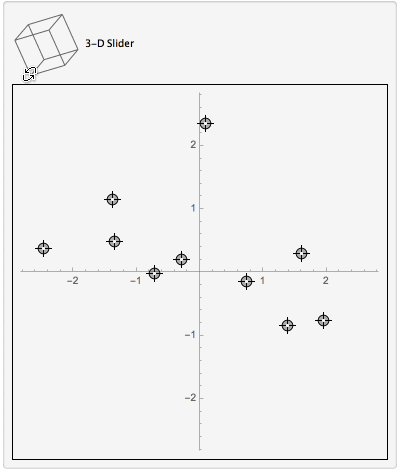I've always enjoyed Mathematica's ability to create interactive figures. However, one challenge is creating 3D locators.
In an effort to create pseudo-3D locators, I designed a locator pane whose locators can be rotated in three dimensions. Said differently, the 2D plane is the projection of locators that would exist in 3D if they had a third dimension. In reality, this is only a starting point proof-of-concept, and is kind of hackey. I use the ViewPoint, ViewVertical, and ViewCenter to determine the geometric transformation needed update the locators' positions as they are moved by rotating a corresponding 3D bounding box, or independently moved within the LocatorPane (the 2D projection of the 3D space). The locators are initialized with a random third dimension. The viewpoint is not at infinity to avoid issues with the cross product, but it's close enough to mimic the desired behavior.

DynamicModule[{aa = 200, vp = {0, 0, 200}, vv = {0, 1, 0},
pts = RandomReal[{-2, 2}, {10, 3}], pts2, zvs},
pts2 = Transpose[{Dot[#, Cross[vv, vp/aa]] & /@ pts, Dot[#, vv] & /@ pts}];
zvs = pts - Map[#[[1]] Cross[vv, vp/aa] + #[[2]] vv &, pts2];
Panel@Column[{
Row[{
EventHandler[
Dynamic@
Graphics3D[{}, ImageSize -> Tiny, Boxed -> True,
ViewPoint -> Dynamic@vp, ViewVertical -> Dynamic@vv,
ViewCenter -> {1/2, 1/2, 1/2},
PlotRange -> {{-2, 2}, {-2, 2}, {-2, 2}}],
{"MouseDragged" :> (
pts2 = Transpose[{Dot[#, Cross[vv, vp/aa]] & /@ pts, Dot[#, vv] & /@ pts}];
zvs = pts - Map[#[[1]] Cross[vv, vp/aa] + #[[2]] vv &, pts2])},
PassEventsDown -> True
], " 3-D Slider"
}],
Framed@EventHandler[
LocatorPane[Dynamic@pts2,
Plot[{}, {x, -2, 2}, PlotRange -> Sqrt[2] {{-2, 2}, {-2, 2}},
ImageSize -> Medium, AspectRatio -> 1]],
{"MouseDragged" :> (
pts = zvs + Map[#[[1]] Cross[vv, vp/aa] + #[[2]] vv &, pts2];
)},
PassEventsDown -> True
]
}]
]